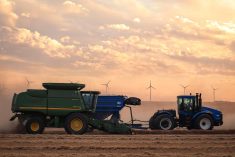CNS Canada — This week’s dump of snow in eastern Saskatchewan and western Manitoba will likely push back fieldwork and fertilizer applications on a lot of farms, according to one crop watcher.
Keystone Agricultural Producers president Dan Mazier, speaking from a conference in the U.S., said only about 50 per cent of the normal amount of fertilizer went on Manitoba fields last fall due to the late harvest.
While many were likely hoping for a dry March to help them get onto fields sooner, that likely won’t be happening.
Read Also

India slaps 30 per cent import duty on yellow peas
India has imposed a 30 per cent duty on yellow pea imports with a bill of lading date on or after Nov. 1, 2025.
“All that pre-melting we had during February is all gone now,” said Mazier. “We’re back to where we started.”
There is a lot of crop to get off first also, he noted, so producers will be scrambling when the ground is dry enough to get on.
“In hindsight it may not be a bad thing that the fertilizer didn’t go on, as there will be runoff with the wet spring,” he said.
The story is a different one in Alberta, where much of the southern part of the province is considerably drier.
“I guess one of the big things to look for is how dry the crop is left out in the field,” said Lynn Jacobson, president of the Alberta Federation of Agriculture.
Speaking from his farm southeast of Calgary, he said some producers are optimistic they’ll be able to start laying down fertilizer next month.
“People will probably be out by the 10th of April working things. Still, you can’t say for sure,” he said.
The price of nitrogen fertilizer has increased slightly since the fall, he said, but many farmers he knows pre-purchased their supplies.
“Probably the large majority of people have pre-bought three-quarters of their usage,” he said.
That approach was taken by a lot of farmers in Manitoba too, according to Mazier.
“Guys have it priced and bought up, but the logistics of getting it onto the ground is the bigger challenge,” he said, adding prices have gone up roughly C$20 a tonne since the fall.
Some producers will likely be buying right now, he added, as not everyone can hang onto fertilizer through the winter.
“You might have got a good deal on the fall but if you can’t get on the land, then you have to store it.”
— Dave Sims writes for Commodity News Service Canada, a Winnipeg company specializing in grain and commodity market reporting. Follow CNS Canada at @CNSCanada on Twitter.











